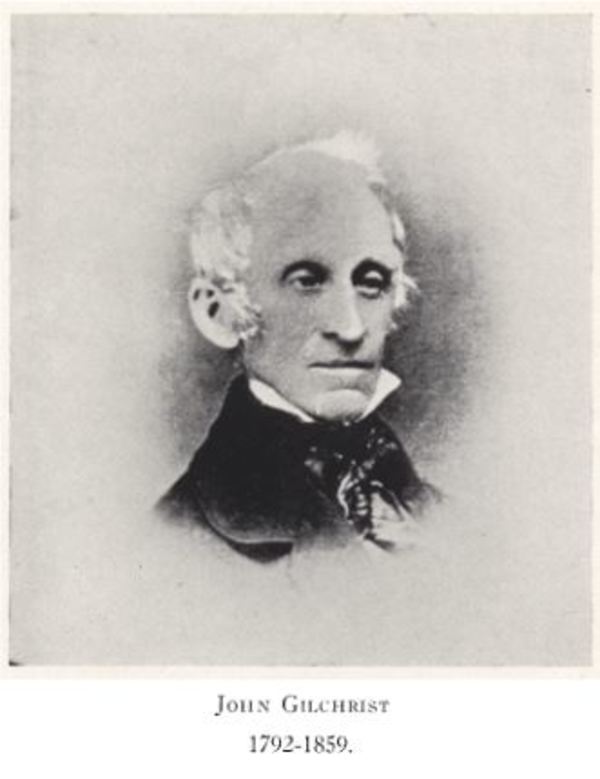
Source: Link
GILCHRIST, JOHN, physician, surgeon, militia officer, businessman, office holder, justice of the peace, and politician; b. 5 Feb. 1792 in Bedford, N.H., eldest son of Samuel Gilchrist, a farmer and mill-owner, and Sarah Aiken; m. 1818 Lucretia Gove, a niece of Zacheus Burnham, and they had nine children; d. 15 Sept. 1859 in Port Hope, Upper Canada, and was buried in nearby Cobourg.
One of four brothers who became doctors, John Gilchrist entered the medical school of Yale College, New Haven, Conn., in 1815. There he attended the lectures of such famous medical and scientific educators as Nathan Smith and Benjamin Silliman, who regarded Gilchrist as a “gentleman in every respect.” His education was completed at Dartmouth College, Hanover, N.H.; Smith also lectured at Dartmouth and on 11 Dec. 1816 certified Gilchrist’s “qualifications for the degree of M.D.” Although Gilchrist did not graduate, he apprenticed in Goffstown, N.H., probably with Dr Jonathan Gove, his future father-in-law, who later recommended him as “a wise-knowing & well inform’d Practioner on whose knowledge fidelity prudence & Care any person or persons may with Confidence & safety rely.”
Gilchrist came to Hamilton Township, Upper Canada, about 1817 and on 5 Jan. 1818 he took the oath of allegiance to the crown. On 5 Jan. 1819 he appeared before the newly established Medical Board of Upper Canada and the following day received its first licence to practise “Physic Midwifery and Surgery.” One of the Cobourg area’s earliest physicians, he was gazetted surgeon in 1822 to the 1st Regiment of Northumberland militia and in 1847 became surgeon with the 7th Battalion of Peterborough militia.
Gilchrist moved north to the Indian River in Otonabee Township, where in 1825–27 he erected a sawmill and a grist-mill in association with Zacheus Burnham and Dugald Campbell, a merchant. The mills soon formed the nucleus of a small settlement, Gilchrist’s Mills, which also became known as Keene after a village near Gilchrist’s childhood home. Regarded as the settlement’s founder, he opened the first general store in 1829 and a distillery in 1831. Although he leased his operations that year in order to resume full-time medical practice in Cobourg, he continued to improve his grist-mill. It was rebuilt in 1833–34 to house a second run of stones and “good flouring machinery.” In 1838 the water supply from the Indian River was increased by cutting a channel from Gilchrist Bay on Stony Lake to the river’s headwaters; Gilchrist was aided in this endeavour by Burnham, who owned a mill on the river at Warsaw, and Thomas Choate, the miller at Warsaw.
Gilchrist’s businesses apparently prospered until 1839, when he experienced the first in a series of set-backs. A large dam constructed at Crooks’ Rapids (Hastings) affected high water levels at Keene and disrupted his milling operations at peak periods. Compensation from the government was slow to come and in 1846 Gilchrist’s petition was still under investigation. Other set-backs resulted in the serious diminution of his landholdings. Between 1825 and 1845 he had purchased some 1,000 acres of land in the Keene area, and in 1834 had begun to sell village lots. In 1840 he was forced to mortgage his mills and surrounding acreage in order to compensate his Lower Canadian agents, Forsyth and Bell of Quebec and Forsyth, McGill and Company of Montreal, for a £1,000 advance and his non-delivery of wheat and lumber. In 1843 more land was tied into a mortgage for nearly £3,500 from his brother-in-law, Mark Burnham of Port Hope, who foreclosed in 1856. Gilchrist’s remaining land was sold by 1846, although his son John remained active at Keene in the lumber trade.
Gilchrist had a colourful career as an office holder and politician. Early in 1831 he was elected a director of the Cobourg Harbour Company. As building committee chairman he laid the cornerstone on 7 June 1832 of Upper Canada Academy in Cobourg. Appointed coroner for the Newcastle District on 3 Jan. 1833, he received his first commission of the peace for that district on 9 Jan. 1835. In October 1833 Gilchrist had closed his medical practice in Cobourg but in 1834 re-established it in Peterborough. Claiming no “pretensions to oratory,” he was narrowly elected that year on a reform platform to the House of Assembly for the riding of Northumberland; its second seat went to Alexander McDonell*, the constitutional candidate.
In the assembly Gilchrist was a conscientious member and supported reform positions except on the issue of banking; he favoured the establishment of more banks throughout the province. He was an effective member of many committees, one of which deliberated the “most eligible route for a Canal to connect Lake Simcoe and Rice Lake.” As well he supported most petitions relating to the Peterborough area, including that which led to the formation of the Colborne District in 1838 with Peterborough as the district town. Gilchrist lost the 1836 election, probably a victim of the strong loyalty vote which resulted in the defeat of other reform candidates. He was accused of disloyal behaviour during the rebellion of 1837 and was arrested that December. Drinking and cheering at his Keene “Still House” on 9 December had preceded a small riot, but charges against him were dropped. In 1841 Gilchrist was elected for the north riding of Northumberland in the united province’s first election.
Apparently an independent and well-respected member, he had always demonstrated a strong interest in local government issues and chaired legislative assembly committees on public improvements, the petition of Robert Fleming Gourlay*, the review of bank charters, and the incorporation of religious societies – interests also shared by William Lyon Mackenzie*. Although Gilchrist did not run for re-election in 1844, he served as a district agent for the Crown Lands Department until 1845, and as Colborne District treasurer from 1842 to 1845.
In 1849 Gilchrist moved from Peterborough to Port Hope, where he practised until his death. It is not clear that he ever worked with his brothers, Hiram and Samuel in Port Hope or James Aiken in Cobourg. John Gilchrist’s accomplishments in medicine and politics were real, and Keene remains an enduring reminder of his talents.
Academy of Medicine (Toronto), ms 67; ms 137. AO, MU 2553; RG 1, A-I-6, 22–24; C-IV, Otonabee Township, concession 6, lots 12–13; RG 22, ser.191, John Gilchrist. BLHU, R. G. Dun & Co. credit ledger, Canada, 22: 93. BNQ, Dép. des mss, mss-101, Coll. La Fontaine (copies at PAC). Can., Parks Canada, Ont. Region (Cornwall), Trent Waterway papers, file F06, Hastings (Crooks Rapids), general, 1, Gilchrist to F. Hall, 17 Oct. 1843. PAC, RG 1, L3, 214A: G2/34, 47–48; 222A: G misc., 1794–1830/97; 221: G leases, 1832/139; RG 68, General index, 1651–1841: 165, 168–70, 490, 503. Peterborough Centennial Museum (Peterborough, Ont.), MG 1-24; MG 1-34; MG 1-77, C-5X; MG 2-6. Peterborough Land Registry Office (Peterborough), Abstract index to deeds, Otonabee Township (mfm. at AO). Debates of the Legislative Assembly of United Canada (Abbott Gibbs et al.), vols.1–3. U.C., House of Assembly, Journal, 1834–36. Valley of the Trent (Guillet), 239, 297–300, 328. Cobourg Star, 8, 15 Oct. 1834. Tri-weekly Guide (Port Hope, [Ont.]), 17 Sept. 1859. Canada directory, 1851, 1857–58. Canadian biog. dict., 1: 560–61. DAB (biogs. of Eli Ives, Benjamin Silliman, Nathan Smith). Illustrated historical atlas of Peterborough County, 1825–1875 (Toronto, 1975), 62–63. Port Hope directory, 1856–57. Canniff, Medical profession in U.C., 38–39, 69–75, 382–85. Cornell, Alignment of political groups. Dave DeBrou, “Political alignments of the Upper Canadian members of the Legislative Assembly: first parliament, 1841–43” (undergraduate essay, Trent Univ., Peterborough, 1975). Forest to farm: early days in Otonabee, ed. D. G. Nelson (Keene, Ont., 1975), 46, 79–80, 114–15. C. M. Godfrey, Medicine for Ontario: a history (Belleville, Ont., 1979). E. C. Guillet, Cobourg, 1798–1948 (Oshawa, Ont., 1948), 238. J. J. Heagerty, Four centuries of medical history in Canada and a sketch of the medical history of Newfoundland (2v., Toronto, 1928), 1: 241. Historical sketch of the township of Hamilton, comp. Walter Riddell (Cobourg, Ont., 1897). Fred Landon, Western Ontario and the American frontier (Toronto, 1941; repr. 1967), 54. John Langton, Early days in Upper Canada: letters of John Langton from the backwoods of Upper Canada and the Audit Office of the province of Canada, ed. W. A. Langton (Toronto, 1926). Lindsey, Life and times of Mackenzie, 2: 376. Bernard McAllister, Reminiscenses of Cobourg (Cobourg, 1918), 80. [F. N. Pickford], “Two centuries of change”: United Counties of Northumberland & Durham, 1767–1967 (Cobourg, 1967). T. W. Poole, A sketch of the early settlement and subsequent progress of the town of Peterborough, and of each township in the county of Peterborough (Peterborough, 1867; repub. 1941, 1967). J. H. Elliott, “John Gilchrist, J.P., L.M.B.U.C., M.D.: a pioneer New England physician in Upper Canada,” Bull. of the Hist. of Medicine (Baltimore, Md.), 7 (1939): 737–50 [includes a photograph of Gilchrist].
Cite This Article
Elwood H. Jones, “GILCHRIST, JOHN,” in Dictionary of Canadian Biography, vol. 8, University of Toronto/Université Laval, 2003–, accessed January 22, 2025, https://www.biographi.ca/en/bio/gilchrist_john_8E.html.
The citation above shows the format for footnotes and endnotes according to the Chicago manual of style (16th edition). Information to be used in other citation formats:
| Permalink: | https://www.biographi.ca/en/bio/gilchrist_john_8E.html |
| Author of Article: | Elwood H. Jones |
| Title of Article: | GILCHRIST, JOHN |
| Publication Name: | Dictionary of Canadian Biography, vol. 8 |
| Publisher: | University of Toronto/Université Laval |
| Year of revision: | 1985 |
| Access Date: | January 22, 2025 |



